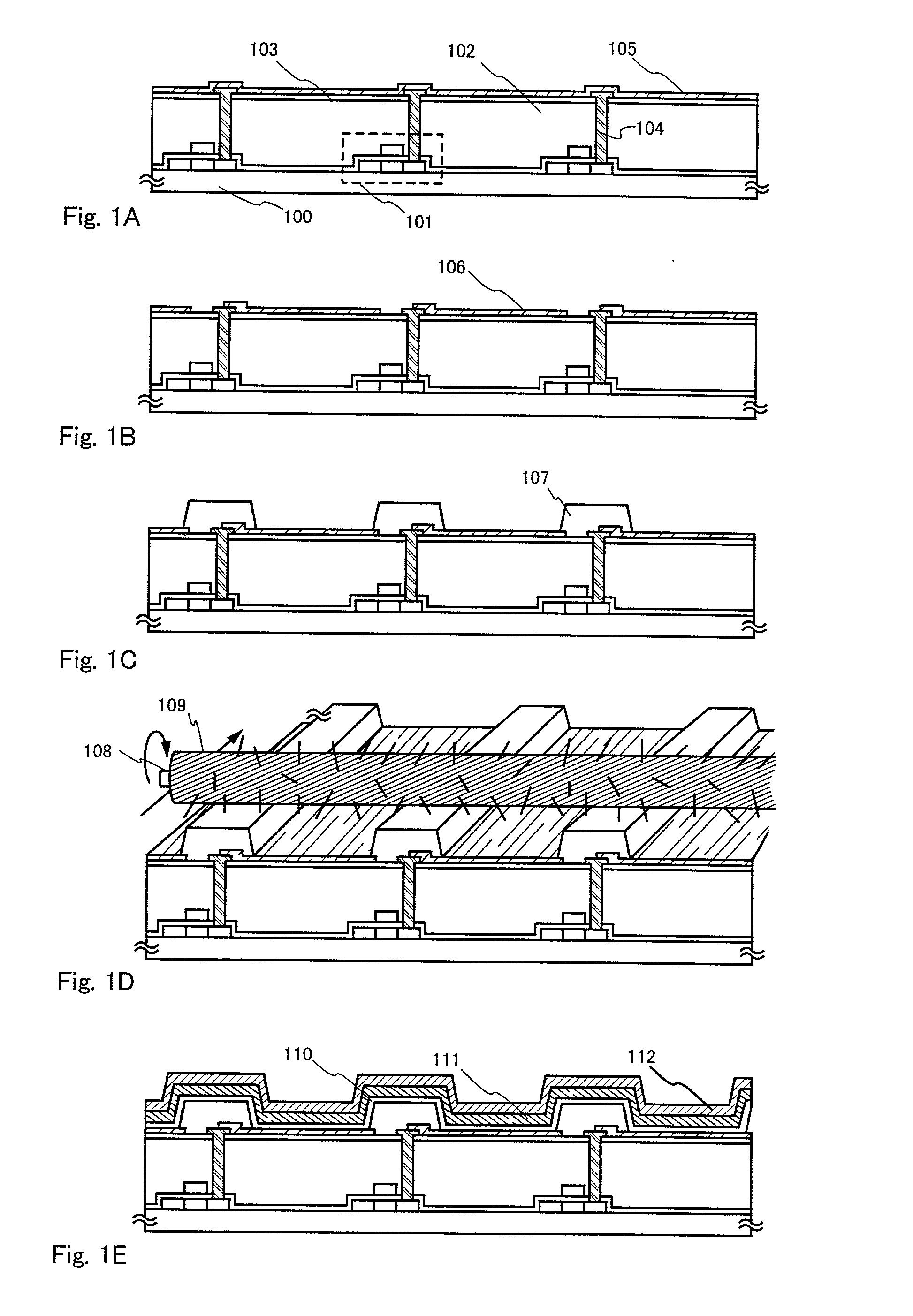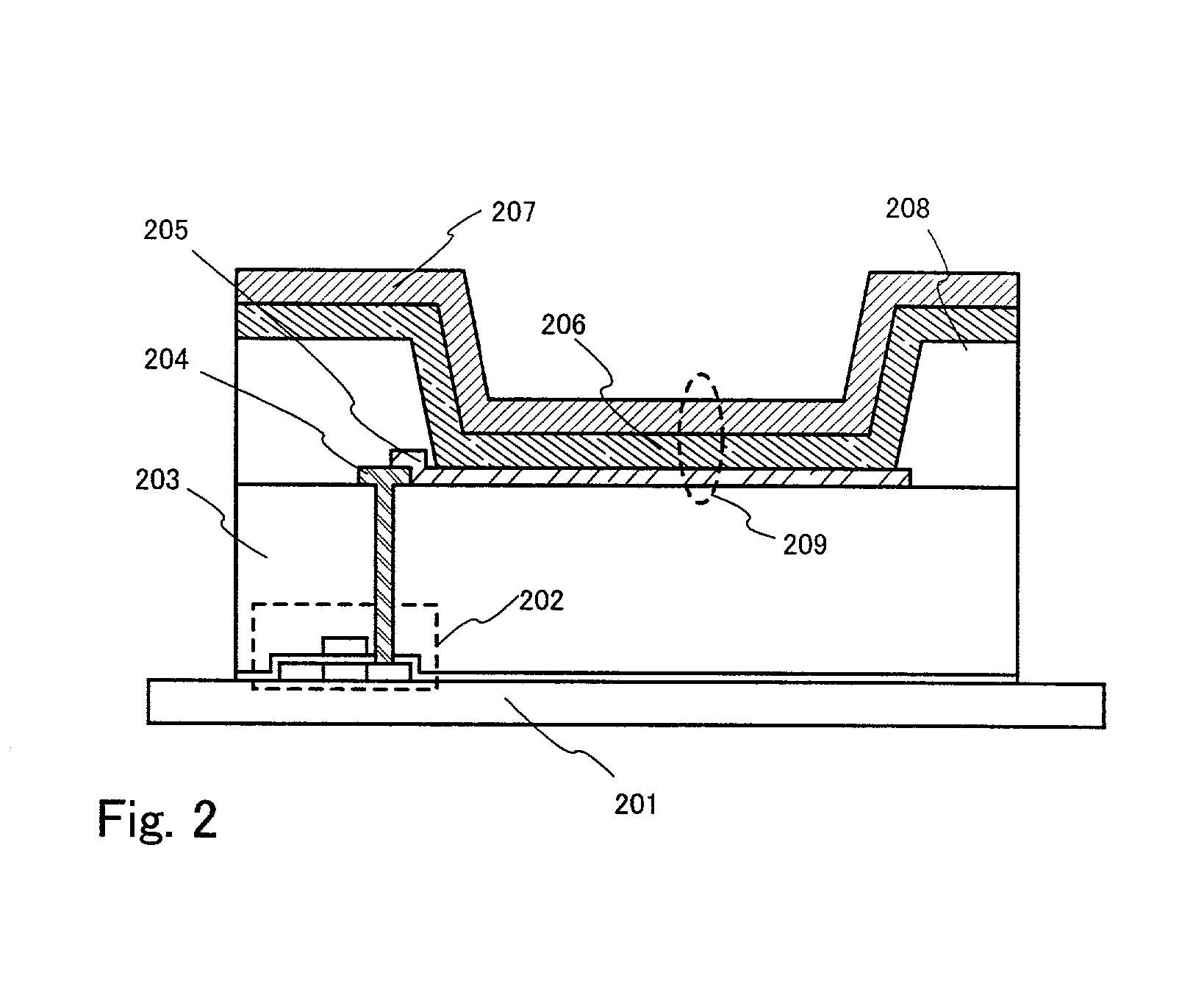Light emitting device and method of manufacturing the same
a technology of light emitting devices and manufacturing methods, applied in semiconductor devices, semiconductor/solid-state device details, instruments, etc., can solve problems such as cracking in the interface, affecting the generation of holes, and reducing the number of holes injected
- Summary
- Abstract
- Description
- Claims
- Application Information
AI Technical Summary
Benefits of technology
Problems solved by technology
Method used
Image
Examples
embodiment 1
[0065] Embodiment 1
[0066] This embodiment gives a description about a light emitting element that is manufactured using the present invention. Described here with reference to FIGS. 3A to 6B is an example of a method of manufacturing TFTs for a pixel portion and TFTs (an n-channel TFT and a p-channel TFT) for a driving circuit at the same time on the same substrate. The pixel portion has the light emitting element of the present invention. The driving circuit is provided in the periphery of the pixel portion.
[0067] First, a glass substrate 900 is prepared. In this embodiment, barium borosilicate glass, typical example of which is Corning #7059 glass or #1737 glass (product of Coming Incorporated), or alumino borosilicate glass is usable as the substrate 900. The substrate 900 can be any light-transmissive substrate, and a quartz substrate may also be used. A plastic substrate may be employed if it has a heat resistance against the process temperature of this embodiment.
[0068] Next, ...
embodiment 2
[0116] Embodiment 2
[0117] This embodiment describes another example of process of manufacturing a light emitting device with reference to FIGS. 19 to 22B.
[0118] Following the description in Embodiment 1, the steps up through the step of forming two layers of conductive films 907 and 908 on the gate insulating film 906 as shown in FIG. 3A are finished.
[0119] Subsequently, a process where the conductive films 907 and 908 are etched using masks 909a to 909d to form conductive layers 3901 to 3904 having a first taper shape is described in FIG. 20A. ICP (inductively coupled plasma) etching is used for this etching. Though etching gas is not limited, CF.sub.4, Cl.sub.2, and O.sub.2 are used to etch a W film and a tantalum nitride film. The gas flow rate of CF.sub.4, Cl.sub.2, and O.sub.2 is respectively set to 25 / 25 / 10, and RF (13.56 MHz) power of 500 W is given to a coiled electrode at a pressure of 1 Pa for the etching. RF (13.56 MHz) power of 150 W is also given to the substrate side (...
embodiment 3
[0141] Embodiment 3
[0142] Following the description of Embodiment 1 or 2, the manufacture process up through the step of forming the second interlayer insulating film (935 or 3926) is finished. Then, instead of forming the first insulating film 936 of Embodiment 1, plasma treatment is performed on the second interlayer insulating film to modify the surface of the second interlayer insulating film (935 or 3926). This method will be described with reference to FIG. 7.
[0143] The second interlayer insulating film (935 or 3926) receives plasma treatment in, for example, one or more kinds of gas selected from the group consisting of hydrogen, nitrogen, hydrocarbon, halogenated carbon, hydrogen fluoride, and rare gas (such as Ar, He, or Ne), so that a coat is newly formed on the surface of the second interlayer insulating film (935 or 3926) or the existing functional group on the surface is changed to a different functional group. The surface modification of the second interlayer insulatin...
PUM
 Login to View More
Login to View More Abstract
Description
Claims
Application Information
 Login to View More
Login to View More - R&D
- Intellectual Property
- Life Sciences
- Materials
- Tech Scout
- Unparalleled Data Quality
- Higher Quality Content
- 60% Fewer Hallucinations
Browse by: Latest US Patents, China's latest patents, Technical Efficacy Thesaurus, Application Domain, Technology Topic, Popular Technical Reports.
© 2025 PatSnap. All rights reserved.Legal|Privacy policy|Modern Slavery Act Transparency Statement|Sitemap|About US| Contact US: help@patsnap.com



